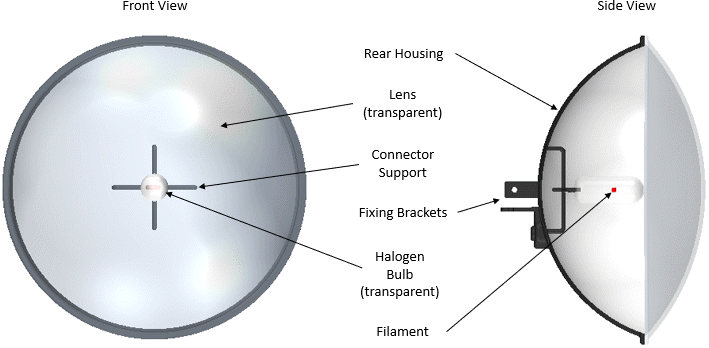Photon Monte Carlo Radiation: Headlamp
Thermal management simulations of headlamp applications allow you to identify temperature hotspots that can cause damage to the headlamp. Modifying the design—for example, including heat shields in the right places—leads to better and more durable designs.
The purpose of this tutorial is to model conjugate heat transfer within a headlamp including radiation with the effects of reflection, refraction, and absorption to predict these critical hotspots. This tutorial is divided into two parts. First, you use the statistical Surface Photon Monte Carlo (SPMC) radiation model to calculate close approximate solutions to the radiative energy transfer between the headlamp surfaces. The SPMC model includes optical refraction at interfaces between regions as well as at external boundaries that face the environment.
In the second part of the tutorial, you investigate the additional effect of absorption within the lens and the halogen bulb on the prediction of the hotspots. For this, you replace the SPMC model with the Volumetric Photon Monte Carlo (VPMC) radiation model in the continuum that applies to these components. The VPMC model accounts for volumetric radiation exchange, that is, participating media radiation. It also facilitates the combination of volumetric and surface radiation modeling in one simulation.
As headlamps are exposed to solar light, which can create focal points close to heat-sensitive surfaces, this tutorial also considers radiation loads from the sun.
The geometry for this tutorial is a generic headlamp, depicted as follows:

The inner surface of the rear housing is modeled as a reflector. The following table lists the radiation properties of the reflector and the transparent headlamp components:
| Radiation Property | Reflector | Halogen Bulb | Lens |
|---|---|---|---|
| Reflectivity | 0.8 | 0.2 | 0.2 |
| Transmissivity | 0.0 | 0.8 | 0.8 |
| Emissivity | 0.2 | 0.0 | 0.0 |
| Refractive Index | - | 1.52 | 1.48 |
Natural convection is the only mechanism that drives the movement of air within the headlamp. The gas inside the halogen bulb has negligible impact on the overall heat transfer and is not included in the simulation.
You run the simulation using monitor based stopping criteria that allow you to judge convergence based on energy residuals and the temperature in the solid components.